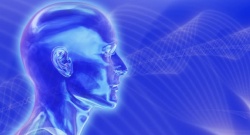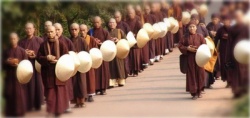The Four Maras
According to Dzigar Kongtrul:
“There are many challenges on this path. These challenges, or maras, are not unique to the West; the works of maras are crucial buddhist teachings. In the Prajnaparamita Sutra, there are many teachings on the challenges and obstacles of maras and how they appear to individuals on the path or to groups trying collectively to establish something positive.”
What does he refer to by “maras?” In Buddhism, Mara personifies incorrect non-Buddhist views, which were the final thing Buddha needed to overcome before manifesting full enlightenment. Mara – meaning ‘the destroyer or tempter’ – was the demonic ‘evil one’ who attempted to obstruct the Buddha’s enlightenment under the bodhi tree and was vanquished in the process.
Buddha’s defeat of Mara is described in several sutras. Mara approached the Buddha when he was practicing asceticism and enjoined him to abandon his practice and instead lead a worldly life involved with helping others. Then Mara sent his “armies”, which the Buddha described as: sensual desire; discontent; hunger and thirst; craving; laziness; fear; doubt; restlessness; longing for transitory gain, praise, honor, and fame; and praising oneself and belittling others. Buddha saw that to overcome these armies, he must stop identifying with them. This Buryatian thangka (left) from the late 19th Century, housed at New York’s Rubin Museum of Art, depicts Buddha overcoming Mara’s armies.
Later, Mara appeared as a poor farmer and as an old wheezing brahmin – symbolizing the conditioned world. Buddha recognized that Mara is in all the aggregates that appear, and told Mara that he cannot hide. Buddha saw him for the pathetic creature that he is, as is symbolized by the pathetic form of the farmer and the brahmin. Mara then appeared as various natural disasters and dangerous wild beasts, but the Buddha had no fear of death. Mara then sent his three daughters to try to seduce the Buddha, but to no avail. Mara then tried to trick the Buddha by agreeing that death is nothing to fear, and can therefore be ignored, but based on that reasoning, he tried to convince the Buddha that life is long and so one can just enjoy it. The Buddha replied that life is short, so one should live “as if one’s head is on fire” and ignore personal risk. Since life can end abruptly at any time, one needs to immediately take advantage of one’s precious human life. At this stage Mara finally gave up and Buddha could proceed to accomplish his goal.
In the early Buddhist sutras “Mara’s army” was described as having four divisions, and in later Mahayana Buddhism these four divisions were personified as the “four maras.” These four maras are described as demonic influences that create obstacles for dharma practice (and therefore enlightenment): those of the aggregates, disturbing emotions, death, and seduction.
the mara of the aggregates (Skt. Skhandamara), which symbolizes our clinging to forms, feelings, perceptions, volition and consciousnesses as real;
the mara of the disturbing emotions (Skt. Kleshamara), which symbolizes our addiction to habitual patterns of negative emotion;
the mara of the Lord of Death (Skt. Mrtyumara), which symbolizes both death itself, which cuts short our precious human birth, and also our fear of change, impermanence, and death; and
the mara of the son of the gods (Skt. Devaputramara), which symbolizes our craving for pleasure, convenience, and ‘peace’.
The four maras work together in unison: in order to encounter Devaputramara – to chase after pleasure like licking honey from a razor – we have to encounter the first two maras. Skandhamara make us think we’re real; then Kleshamara causes us to fixate on our projections – phenomena that are not what we think they are, but what we want them to be. The encounter with Mrtyumara convinces us of the finality of death and initiates a “backward chain reaction”: if death is real, then life is real, I am real, and what I am doing is real. This further fools us into imputing solidity to our life even though everything conditioned is impermanent and has no absolute truth. When we die it seems as if something is gone, but it was always coming and going, we just mistook this coming and going as a self which dies.
According to Sakyong Mipham Rinpoche:
The Buddhist teachings tell us that life is actually an illusion. Although it’s a little late, it’s usually only just before we die that we recognize how illusory the whole thing is. My teacher Dilgo Khyentse Rinpoche said that as we’re lying on our deathbed, life looks like the movement of a lama dancer’s robes, as fluid as cloth in the wind. Our whole life we regard death as finality, but like life, death is also illusory. Who is the individual dying? Who is living? Is anybody actually there?
Iconographically, in Vajrayana Buddhism the four maras are represented in the forms of Hindu gods, depicted as being trampled under the feet of wisdom aspects such as Hevajra:
According to Robert Beer:
“In Vajrayana Buddhism the armies of Mara represent all of the mental and emotional delusions that arise as ‘demonic enemies or fiends’, and the function of many of the weapons held by Vajrayana deities are to slay, crush, pierce, cut and sever the negative or evil influences of the four maras.”
Tulku Urgyen Rinpoche offers a different angle on the four maras from the perspective of Dzogchen and Mahamudra:
“The first of the four demons is the demon of the Lord of Death, which cuts our life short. Second is the demon of the physical aggregates, which prevents the attainment of the rainbow body. Third is the demon of the disturbing emotions, the three poisons which prevent liberation from samsara. Finally there is the demon of the son of the gods, which is distraction in the meditation state and the tendency to postpone practice. Procrastination is the mara of the son of the gods, which creates obstacles for samadhi. The real demon is our conceptual thinking. Falling into conceptualization is the demon. By recognizing our mind essence, all demons are defeated; the four maras are vanquished and all obstacles are done away with. The main point is to train in that.”


